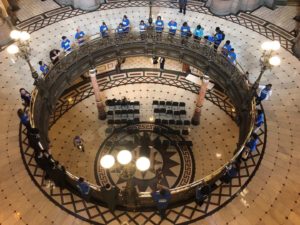As more schools start 2022 with remote learning, advocates say 2021 was ‘historic year’ for choice
(Bethany Blankley | The Center Square) – As school districts across the U.S. start 2022 in remote-learning settings or are considering doing so because of a rise in COVID-19 cases, parents now have…

(Bethany Blankley | The Center Square) – As school districts across the U.S. start 2022 in remote-learning settings or are considering doing so because of a rise in COVID-19 cases, parents now have more options as 22 states expanded or created school choice initiatives in 2021.
That’s a silver lining, advocates say, as parents grow more frustrated by ever-changing mandates, failed virtual learning outcomes and conflicting views with school boards over a range of issues.
Last year was an “historic year for school choice in America,” the American Federation for Children said in its analysis of “school choice victories.”
“A record number of states passed legislation to create, expand, or improve school choice programs and hundreds of thousands of children stand to benefit,” it added.
Nearly half of all state legislatures last year increased funding for school choice programs in their state budgets or passed laws to expand or create new Education Savings Accounts (ESAs) or scholarship programs. They also notably expanded eligibility requirements to include home-schooling, charter schools and private schools.
Four states created entirely new programs; three created new and expanded programs, and Ohio created the most improved programs of them all, according to the analysis. The majority, 14, either expanded or improved their existing school choice programs.
The state legislatures of Kentucky, Missouri, New Hampshire and West Virginia all created new scholarships or ESA programs in 2021, according to the analysis.
Kentucky created its first ESA, a $25 million tax credit program, and became the 28th state to have a private school choice program. Private school choice is now available to students in counties with a population more than 90,000, according to a new law.
Missouri created a new $25 million ESA program funded by a 100% tax credit. Eligible students, prioritized by income, include those who attend public, charter, virtual and private schools or those who are home-schooled.
New Hampshire’s ESA program is designed to help families earning up to 300% of the federal poverty limit and the state Department of Education projects it will save the state $350 million over the next decade.
A new West Virginia law created a new ESA program, the Hope Scholarship, available to 90% of students in the state. It allows those leaving the public school system to use the funds for private school tuition, home-schooling costs, or other educational expenses.
State legislatures in Arkansas, Indiana and Florida created new and expanded school choice programs.
Arkansas created a new $2 million tax credit program to help eligible low-income students, which includes a 100% tax credit for donors. It also amended eligibility for a state scholarship program to include children of active-duty or reserve members of the U.S. military.
Indiana’s biennial budget expanded eligibility criteria and increased the tax credit cap for its voucher and tax credit scholarship program and created a new ESA program. It also allocated additional funding to its special needs ESA and charter and innovation network grants.
New Florida laws expanded the state’s scholarship programs and created a new ESA program. They expanded household income eligibility, increased the number of scholarships made available every year and their amounts, and amended programs to better help students with disabilities, among other measures.
Ohio’s budget increased funding for its EdChoice and Cleveland Scholarships, expanded eligibility criteria and increased the value of special needs scholarships. It also doubled facility funding to brick and mortar charter schools and invested $54 million in high-quality charter schools. By eliminating geographic restrictions on the location of charter schools, and eliminating deductions from districts’ state aid, Ohio moved to directly fund scholarship programs and charter schools.
It also created a new state tax credit for individual contributions, allowing private school students to be recipients, and created a new ESA program to help low-income students.
Ten state legislatures (Georgia, Iowa, Kansas, Maryland, Montana, Nevada, North Carolina, Oklahoma, Pennsylvania and South Dakota) expanded their existing school choice programs last year, some by record amounts.
Georgia expanded access to its special needs voucher program to approximately 50,000 students; Kansas expanded its tax scholarship program and removed some eligibility requirement restrictions; Maryland increased funding by roughly one-third for its “BOOST” scholarship program.
Iowa increased the cap for its tax credit scholarship program by the largest amount in the program’s history. It also increased tax credits for donations to 75%, doubled the parental tuition tax credit, and allowed homeschool families to be eligible for the tax credit.
Montana expanded its tax credit scholarship and ESA programs, increasing the maximum tax credit donors can receive to $200,000. The program cap was increased to $2 million in 2023, with the ability to increase it every year depending on donation amounts.
Nevada expanded its Opportunity Scholarship Program to $22.8 million for the next biennium “and a harmful provision preventing children from entering the program was erased,” AFC notes.
North Carolina’s budget expanded eligibility for its scholarship program and raised the income threshold to qualify for it. It also expanded the scholarship amount to 90 percent of the state per pupil expenditure for traditional public schools and combined a grant for children with disabilities with its ESA program. The new ESA could provide up to $17,000 in aid to students with disabilities.
Oklahoma also expanded its tax credit scholarship program, increasing the amount of annual tax credits available for private school scholarship donations by roughly seven-fold.
Pennsylvania increased funding for its K-12 tax credit program by $40 million, which is expected to help an additional 13,000 students.
South Dakota expanded and amended its tax credit scholarship program eligibility requirements to allow students of any income or grade to apply, including those enrolled in private schools.
While Illinois and Tennessee made improvements to their existing school choice programs, Arizona and Louisiana improved and expanded theirs.
Illinois extended its tax credit scholarship program sunset by one year; a new Tennessee law clarifies that funds made to, or on behalf of, students participating in the state’s ESA program are exempt from state and local taxation.
Arizona made access to its ESAs easier, including allowing all low-income families with students that attend failing public schools to immediately enroll in the program. It also allocated new funding for charter school transportation, expanded funding for high-performing charter schools, increased transparency in its open enrollment system, and added $1 million to its tuition tax credit program serving children with special needs.
Louisiana also expanded options for families whose children are enrolled in failing public schools, allowing them to select a better rated school and appeal to the state if their children were denied enrollment to their public school of choice. The state’s scholarship program was also changed to expand eligibility and improve accountability.



